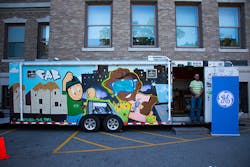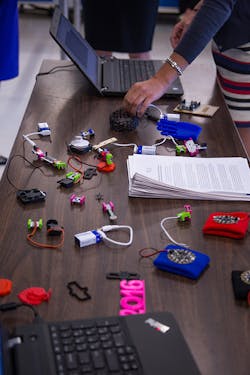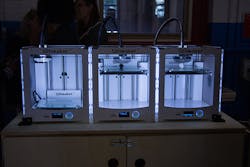This file type includes high-resolution graphics and schematics when applicable.
Kelli List Wells is the Executive Director for Global Education and Skills at the General Electric (GE) Foundation. Her portfolio focuses on building education, skills, and training initiatives to prepare the next generation for the demands of the workforce and the changing labor economy both nationally and globally.
Wells sat down with Machine Design to talk about GE’s new mobile lab. Wells’ hope is to spread STEM interest and education in Boston-area schools, and eventually the nation. Wells talks a little about her background, why GE made a mobile lab, and what equipment is inside.
How has your previous experience brought you to the position you are in today?
I have worked at GE since 1995. I’ve served as Executive Director of Education and Skills at the GE Foundation since 2015, with a major focus on the development of global programs to solve one of the most prevalent issues facing millions of people today—the skills gap.
While visiting schools and businesses throughout the U.S., I’ve confirmed my belief that the skills gap affects individuals’ ability to enter the workforce and maintain employment. In addition, the skills gap affects our national and global economy. At GE, we’re working to narrow this gap to help people around the world build a collaborative culture, where all work together to accomplish company and individual goals and equip people for the future of work in innovative careers.
What is a specific example of the work the GE Foundation is doing to narrow the skills gap?
One unique approach was a recently launched collaboration with Boston Public Schools called the GE Brilliant Career Lab. It’s an interactive technology lab designed to prepare students for innovative digital industrial jobs of the future, including wearable technology design, machinery, biomedical engineering, software/game development, and airplane mechanics.
The lab has two components: a mobile lab that offers hands-on training and a website full of quizzes and details on STEM careers of the future. The mobile lab is now launching at Boston-area public high schools with the goal of taking the program nationally in the future.
What is included in the mobile lab?
Exploration of current and emerging innovation digital industrial careers are possible through a specially developed curriculum created for interaction and career understanding. Students will learn the skills and education required to gain and retain jobs in these industrial fields, as well as the degrees and allied certifications and re-certifications necessary and how they can access them.
Students will also study essential skills modules that introduce them to the skills that are important to success in the workplace. They will learn skills for effective communication, collaboration, work ethic, emotional intelligence, and more.
Through the mobile lab, students will become familiar with new technologies, such as 3D printers, laser cutters, milling machines, and programming tools. They will be able to work on projects to help them understand the uses and features of the equipment.
What careers are highlighted in the mobile lab?
Based on comprehensive research, the mobile lab is starting out by focusing on five futuristic, technology-oriented career areas, although the skills can apply to many careers. The first five are wearable technology design, machinery, biomedical engineering, software/game development, and airplane mechanics. These careers were specifically selected based on identified areas of need in the national workforce to ensure we are paving a direct road for these students, from their education to a career.
• The Wearable Technology Design lesson is designed to help students understand more about wearable technology, a field experiencing consistent growth with 256,400 projected job openings expected over the next decade. The lesson will involve students in designing and coding their own activity tracker (similar to a Fitbit).
• The Machinist lesson offers students the chance to learn about the broad field of computer-numeric-control (CNC) machining—the automation of machine tools that are operated by precisely programmed commands encoded on a storage medium. Another fast-growing field, there are expected to be 154,700 job openings in machinery over the next decade. This lesson focuses on the basics of machining/metal fabrication by utilizing CNC machines to create custom tools.
• For the Biomedical Engineering activity, students will learn the basic skills of 3D modeling and how those skills can be applied to the healthcare field. Utilizing 3D scanners and printers, they will build a 3D model of a body part and talk about how doctors can utilize 3D modeling software to prepare for surgery. Building these skills again could help students enter a profession with incredible opportunity for growth, with 10,900 job openings projected over the next decade.
• The Software/Game Development lesson engages students in the basics of coding and how it can be applied to app development. Students will utilize the Scratch Online programming environment to code a basic game and learn basic programming syntax. This field is also growing much faster than average, with 238,000 projected job openings over the next decade.
• The Airplane Mechanics lesson focuses on using Arduino boards to control servo motors and other elements of electronics commonly found in model airplanes and quadcopters. These skills will be translated into necessary topics that relate directly to the field of aviation and mechanics. This field is experiencing consistent growth, also with 30,100 projected job openings during the next decade.
How will the virtual lab benefit students?
The Brilliant Career Lab website has tools to help students with career planning and preparation. The site houses career assessments that identify potential STEM-related careers paths and interactive activities that teach students about opportunities based on their interests and skills.
Students start exploring by completing a brief Interest Assessment to determine their skills, career interests, and abilities. Next, students move onto game-like “Essential Skills” training designed to help them expand their emotional intelligence and develop and hone workplace skills. Points and badges are earned by completing fun and interactive activities, such as self-assessment tests that help student’s identify their unique traits and strengths.
In Career Exploration, students see the results of their initial assessment and learn about careers that best fit their interests and skills. Career profiles explain essential job functions and provide students with career educational requirements, including direction to related high-school and post-secondary classes. Students can research job demand and salaries based on data from Glassdoor and the U.S. Department of Labor. In addition, students can begin developing job-related technical skills, such as computer coding, right in the lab with integrated Khan Academy exercises. The virtual lab even provides students the opportunity to apply for jobs within their desired career path directly through the site.
The GE Virtual Brilliant Career Lab can be used in and out of the classroom by students. Careers of interest can be shared by students, with parents, or guidance counselors to aid in career readiness preparation. With this knowledge in hand, students are able to interact with the Virtual Brilliant Career Lab, which will assist them in identifying their career interest, build soft skills, and explore STEM careers.
Why did the GE Foundation create the Brilliant Career Lab?
The Brilliant Career Lab is a centerpiece of the GE Foundation’s $25 million investment to support Boston Public Schools students and educators, an important piece of a larger, ongoing commitment from GE to the City of Boston as GE moves its headquarters to the city. Through the $25 million commitment, GE has the potential to reach thousands of high-school students in Boston Public Schools each year with career labs and computer science courses. Also, the educator professional development experiences help educators prepare students for tomorrow’s workforce.
To best fill the needs of the students, GE conducted a listening tour with Boston Public Schools students, teachers, and administrators to identify their greatest needs and how the GE Foundation can best support them. This investment will provide students with the opportunity to explore college and career possibilities, and to understand the skills and computer-science experience/training for all high-school students that is necessary for future employment. GE will also help STEM high-school teachers better prepare students for college and their future careers.






